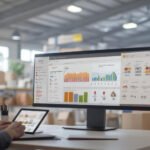Zennemis – Data Analytics for Accounting 3rd Edition. How can embracing data analytics change the role of accountants in today’s fast-paced financial world? In our look at the Data Analytics for Accounting 3rd Edition, we find key insights that show a big change in the accounting field. This book, by Vernon J. Richardson, Ryan Teeter, and Katie Terrell, teaches the value of accounting data analytics. It shows how important it is for making decisions based on data as data grows to 149 zettabytes by 2024. Accountants need to learn financial data analysis skills.
The IMPACT Cycle is at the core of this book. It’s a step-by-step guide for future accountants. It helps them ask questions, work with data, analyze it, share findings, and track results. Knowing this cycle is crucial for using accounting technology well. The book also offers practical exercises with real data and introduces various accounting information systems. This prepares us for the challenges and chances in today’s accounting world.
The Importance of Data Analytics in Accounting
In today’s fast-changing financial world, using data analytics in accounting is crucial. We must adapt our financial analysis to keep up with the wealth of information available. Making decisions based on data is key to success in accounting. It helps professionals use large amounts of data to find insights that guide smart strategies.
Understanding Data-Driven Decision Making
Data-driven decisions give accountants the tools to make sense of the information they have. With data expected to grow to 149 zettabytes by 2024, we need to adapt. Using accounting data analytics lets us do deep financial analysis. This leads to better financial reporting and auditing.
This change improves our decision-making and makes our work more efficient. We focus on logic and reason, not just collecting data.
Critical Skills for Future Accountants
To succeed in this data-focused world, we need to develop key skills. Being good at analytical thinking, handling data, and understanding accounting systems is crucial. Using tools like Excel and Power BI can boost our analysis abilities.
Knowing the IMPACT cycle is important too. It includes asking questions, mastering data, testing plans, refining results, and sharing insights. As we get better at these skills, we can meet our organization’s information needs. This helps us make data-driven decisions.
Overview of the Data Analytics for Accounting 3rd Edition
The “Data Analytics for Accounting 3rd Edition” is a key resource for future accountants. It combines practical skills with the latest in accounting technology. This book shows the value of important tools that make learning easier for students. It mixes theory with practice to help us handle today’s complex accounting challenges.
Key Features and Tools Provided
This textbook includes various features and tools for better learning. Highlights include LMS integration, adaptive assignments, and detailed student progress reports. It also offers presentation slides and remote proctoring with Proctorio for flexible learning. These tools help students learn how to use accounting data visualization techniques and tools.
| Feature | Description |
|---|---|
| LMS Integration | Seamless integration with Learning Management Systems for streamlined educational delivery. |
| Adaptive Assignments | Customizable assignments tailored to individual student needs, enhancing engagement and comprehension. |
| Student Progress Analytics | Tools for tracking student performance, allowing for timely interventions and support. |
| Remote Proctoring | Secure online exam monitoring using Proctorio, ensuring integrity and compliance. |
| Interactive Exercises | Practical exercises that stimulate critical thinking and reinforce key concepts in accounting. |
The IMPACT Cycle Explained
The IMPACT cycle is at the core of the textbook. It’s a framework that guides us through data analytics in accounting. The cycle includes five stages: Identify questions, Master data, Perform analysis, Communicate insights, and Track outcomes. This approach teaches us key skills for solving problems in our fast-changing business world.
Learning the IMPACT cycle helps us make smart decisions with strong data visualization. It helps us in class and sets a strong base for our careers in accounting.
Data Analytics Tools and Techniques for Accountants
Accountants now rely on data analytics tools to make better decisions. Tools like Excel, Power BI, and Tableau are key for success in accounting tech. These tools help us work more efficiently and give us deeper financial insights.
Popular Tools: Excel, Power BI, and Tableau
Excel is still a go-to for data work in accounting. It lets us do complex calculations and make charts easily. Even with new tools coming out, Excel’s flexibility keeps it a must-have for many.
Power BI has become very popular for its reporting features. It helps us make dashboards that turn complex data into something easy to understand. Sharing insights through reports makes it easier for everyone to make good decisions.
Tableau focuses on making data look good. It helps accountants show data in a way that’s easy to get. This makes it easier to see big data and support business plans and efficiency.
Using these tools makes us more efficient and sharp. As accounting gets more complex, being able to see and understand data well is key. This leads to better business solutions. Here’s a look at these tools:
| Tool | Primary Functionality | Key Features |
|---|---|---|
| Excel | Data manipulation and analysis | Formulas, pivot tables, and charting capabilities |
| Power BI | Reporting and interactive dashboards | Data connections, real-time analytics, sharing options |
| Tableau | Advanced data visualization | Drag-and-drop interface, extensive visualization options, storytelling features |
Knowing and using these tools helps us serve our clients and organizations better. Being able to analyze and share insights through visualization is key in today’s data-focused world.
Data Analytics for Accounting 3rd Edition: A Curriculum Overview
The “Data Analytics for Accounting 3rd Edition” curriculum offers a balanced education. It covers both theory and practical skills. Students get hands-on practice through assignments and projects. This prepares them for the data-driven world of accounting.
Hands-On Practice with Real-World Data Sets
We use five types of assignments across key areas to deeply engage students. Digital tools help instructors assess students easily, letting them focus on learning. The curriculum builds students’ skills from the basics to advanced levels.
Industry leaders want accountants with critical thinking and skills. Our curriculum meets this need by using real-world data sets in assignments. For example, Excel and Tableau assignments help students practice with these tools.
Students also work with Power BI to analyze data and create reports. This helps them understand complex data better. Throughout the semester, instructors use data analytics cases to show how analytics fits into financial accounting.
Instructors say that knowing various data analytics tools is key. It makes students ready for top careers. Our curriculum is designed with industry advice, making our graduates sought after by employers.
| Aspect | Details |
|---|---|
| Assignments Offered | 5 types across core course areas |
| Assessment Tools | Majority are auto-gradable |
| Skill Development | Progressive enhancement from introductory to capstone |
| Industry Demand | High demand for accounting graduates with data analytics skills |
| Software Utilized | Excel, Tableau, Power BI, GoogleSheets, Python, Alteryx, Access, UiPath, ChatGPT |
Conclusion: Data Analytics for Accounting 3rd Edition
Data Analytics for Accounting 3rd Edition is a key resource for students and professionals. It deepens our grasp of accounting technology and prepares us for the complex world of data-driven decisions. With 139 pages of new content for 2024, it shows how vital data analytics is in accounting.
As analytics becomes more important, learning to make sense of data is crucial. The fact that 48,187 documents were sold last month shows how much people want to learn about data-driven methods. At just $29.49, this book is a smart buy for those looking to grow their skills in a data-rich world.
This book does more than just teach about data analytics. It prepares us for a future where automation and analytical tools change how we audit. By using these insights, we can boost our performance and bring great value to our companies. This ensures we’re ready for the changing world of accounting.
FAQ: Data Analytics for Accounting 3rd Edition
What is the main focus of “Data Analytics for Accounting 3rd Edition”?
This book focuses on how data analytics fits into accounting. It shows why analyzing financial data and making decisions based on data is key for accountants.
What does the IMPACT cycle entail?
The IMPACT cycle has five steps: Identify questions, Master data, Analyze, Communicate results, and Track outcomes. It helps future accountants use data analytics well in their jobs.
How can tools like Excel, Power BI, and Tableau be beneficial for accountants?
Tools like Excel, Power BI, and Tableau help accountants work with and see data better. Excel is great for data work. Power BI and Tableau make dashboards and data presentations interactive.
Why is hands-on practice important in the curriculum?
Hands-on practice with real data sets gets students ready for real-world challenges. It also makes the concepts they learn more meaningful.
What critical skills do future accountants need to develop according to the textbook?
Future accountants need to think analytically, work with data well, understand accounting systems, and use data analytics tools.
How does “Data Analytics for Accounting 3rd Edition” prepare students for data-driven decision-making?
The book gives students the tools and frameworks they need. It encourages them to use their knowledge in real situations. This helps them make smart, data-based choices.




